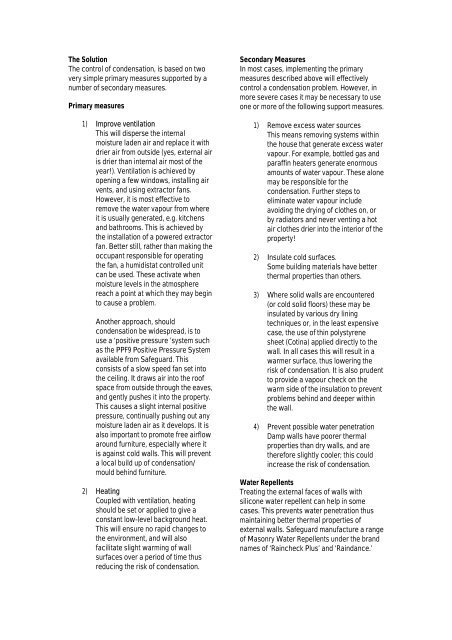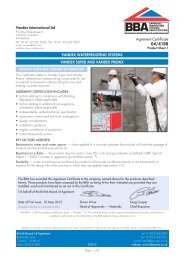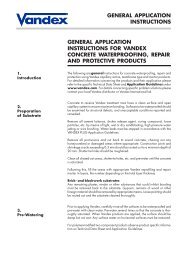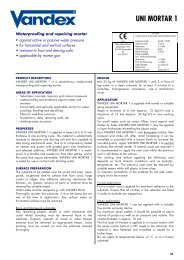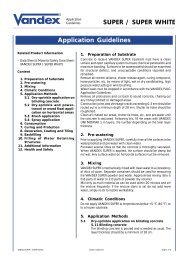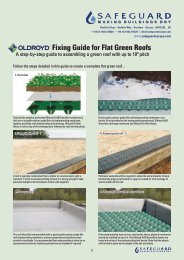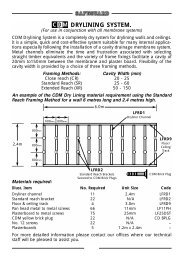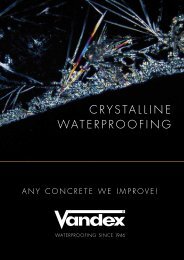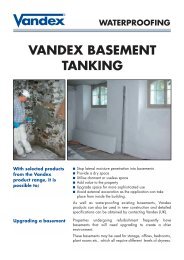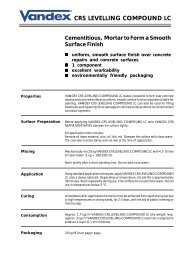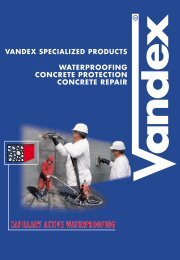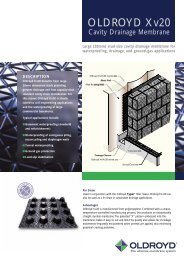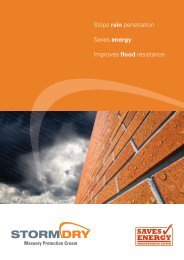A Guide to Condensation in Buildings - Safeguard Europe Ltd.
A Guide to Condensation in Buildings - Safeguard Europe Ltd.
A Guide to Condensation in Buildings - Safeguard Europe Ltd.
You also want an ePaper? Increase the reach of your titles
YUMPU automatically turns print PDFs into web optimized ePapers that Google loves.
The Solution<br />
The control of condensation, is based on two<br />
very simple primary measures supported by a<br />
number of secondary measures.<br />
Primary measures<br />
1) Improve ventilation<br />
This will disperse the <strong>in</strong>ternal<br />
moisture laden air and replace it with<br />
drier air from outside (yes, external air<br />
is drier than <strong>in</strong>ternal air most of the<br />
year!). Ventilation is achieved by<br />
open<strong>in</strong>g a few w<strong>in</strong>dows, <strong>in</strong>stall<strong>in</strong>g air<br />
vents, and us<strong>in</strong>g extrac<strong>to</strong>r fans.<br />
However, it is most effective <strong>to</strong><br />
remove the water vapour from where<br />
it is usually generated, e.g. kitchens<br />
and bathrooms. This is achieved by<br />
the <strong>in</strong>stallation of a powered extrac<strong>to</strong>r<br />
fan. Better still, rather than mak<strong>in</strong>g the<br />
occupant responsible for operat<strong>in</strong>g<br />
the fan, a humidistat controlled unit<br />
can be used. These activate when<br />
moisture levels <strong>in</strong> the atmosphere<br />
reach a po<strong>in</strong>t at which they may beg<strong>in</strong><br />
<strong>to</strong> cause a problem.<br />
Another approach, should<br />
condensation be widespread, is <strong>to</strong><br />
use a ‘positive pressure ’system such<br />
as the PPF9 Positive Pressure System<br />
available from <strong>Safeguard</strong>. This<br />
consists of a slow speed fan set <strong>in</strong><strong>to</strong><br />
the ceil<strong>in</strong>g. It draws air <strong>in</strong><strong>to</strong> the roof<br />
space from outside through the eaves,<br />
and gently pushes it <strong>in</strong><strong>to</strong> the property.<br />
This causes a slight <strong>in</strong>ternal positive<br />
pressure, cont<strong>in</strong>ually push<strong>in</strong>g out any<br />
moisture laden air as it develops. It is<br />
also important <strong>to</strong> promote free airflow<br />
around furniture, especially where it<br />
is aga<strong>in</strong>st cold walls. This will prevent<br />
a local build up of condensation/<br />
mould beh<strong>in</strong>d furniture.<br />
2) Heat<strong>in</strong>g<br />
Coupled with ventilation, heat<strong>in</strong>g<br />
should be set or applied <strong>to</strong> give a<br />
constant low-level background heat.<br />
This will ensure no rapid changes <strong>to</strong><br />
the environment, and will also<br />
facilitate slight warm<strong>in</strong>g of wall<br />
surfaces over a period of time thus<br />
reduc<strong>in</strong>g the risk of condensation.<br />
Secondary Measures<br />
In most cases, implement<strong>in</strong>g the primary<br />
measures described above will effectively<br />
control a condensation problem. However, <strong>in</strong><br />
more severe cases it may be necessary <strong>to</strong> use<br />
one or more of the follow<strong>in</strong>g support measures.<br />
1) Remove excess water sources<br />
This means remov<strong>in</strong>g systems with<strong>in</strong><br />
the house that generate excess water<br />
vapour. For example, bottled gas and<br />
paraff<strong>in</strong> heaters generate enormous<br />
amounts of water vapour. These alone<br />
may be responsible for the<br />
condensation. Further steps <strong>to</strong><br />
elim<strong>in</strong>ate water vapour <strong>in</strong>clude<br />
avoid<strong>in</strong>g the dry<strong>in</strong>g of clothes on, or<br />
by radia<strong>to</strong>rs and never vent<strong>in</strong>g a hot<br />
air clothes drier <strong>in</strong><strong>to</strong> the <strong>in</strong>terior of the<br />
property!<br />
2) Insulate cold surfaces.<br />
Some build<strong>in</strong>g materials have better<br />
thermal properties than others.<br />
3) Where solid walls are encountered<br />
(or cold solid floors) these may be<br />
<strong>in</strong>sulated by various dry l<strong>in</strong><strong>in</strong>g<br />
techniques or, <strong>in</strong> the least expensive<br />
case, the use of th<strong>in</strong> polystyrene<br />
sheet (Cot<strong>in</strong>a) applied directly <strong>to</strong> the<br />
wall. In all cases this will result <strong>in</strong> a<br />
warmer surface, thus lower<strong>in</strong>g the<br />
risk of condensation. It is also prudent<br />
<strong>to</strong> provide a vapour check on the<br />
warm side of the <strong>in</strong>sulation <strong>to</strong> prevent<br />
problems beh<strong>in</strong>d and deeper with<strong>in</strong><br />
the wall.<br />
4) Prevent possible water penetration<br />
Damp walls have poorer thermal<br />
properties than dry walls, and are<br />
therefore slightly cooler; this could<br />
<strong>in</strong>crease the risk of condensation.<br />
Water Repellents<br />
Treat<strong>in</strong>g the external faces of walls with<br />
silicone water repellent can help <strong>in</strong> some<br />
cases. This prevents water penetration thus<br />
ma<strong>in</strong>ta<strong>in</strong><strong>in</strong>g better thermal properties of<br />
external walls. <strong>Safeguard</strong> manufacture a range<br />
of Masonry Water Repellents under the brand<br />
names of ‘Ra<strong>in</strong>check Plus’ and ‘Ra<strong>in</strong>dance.’


